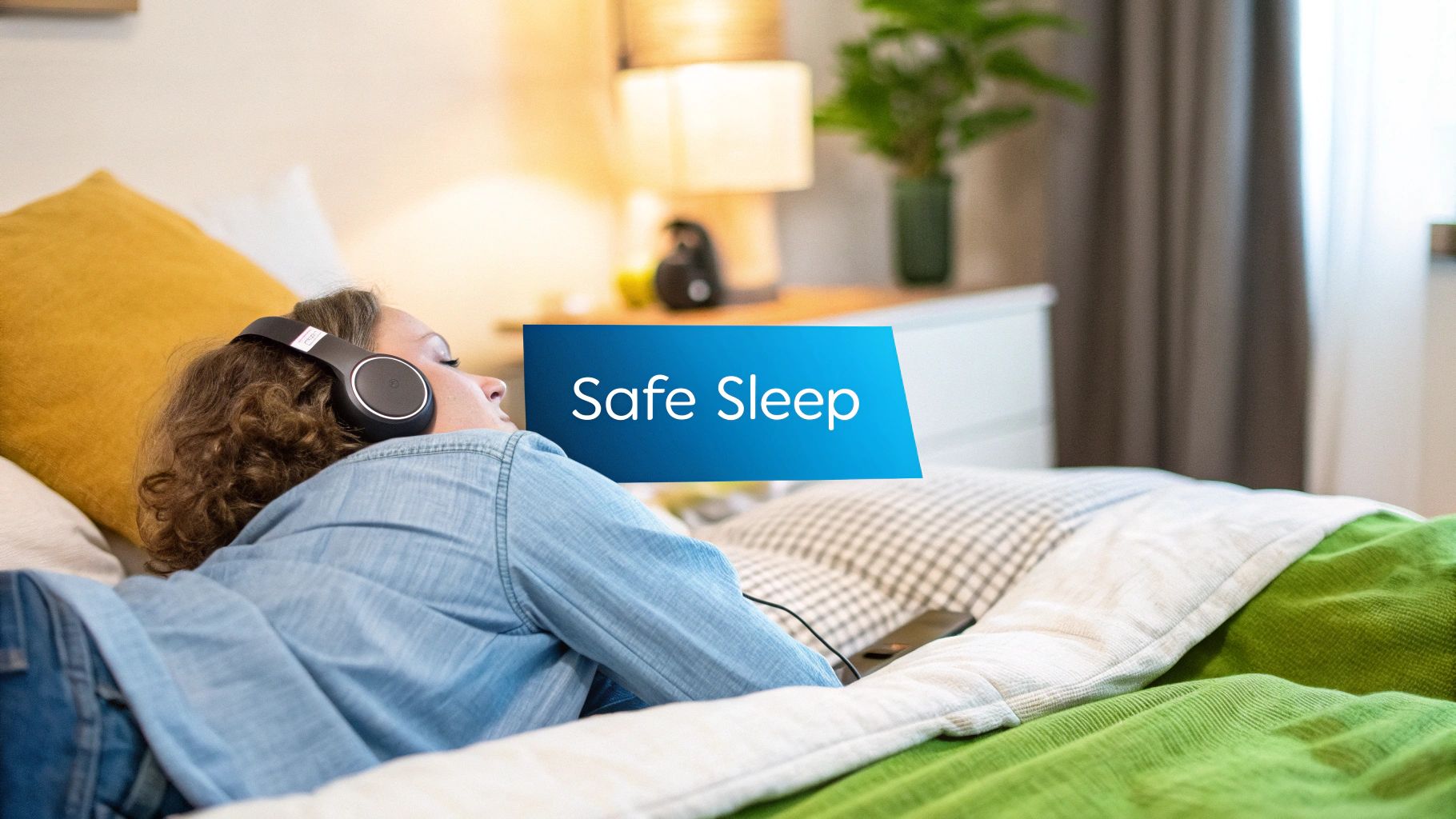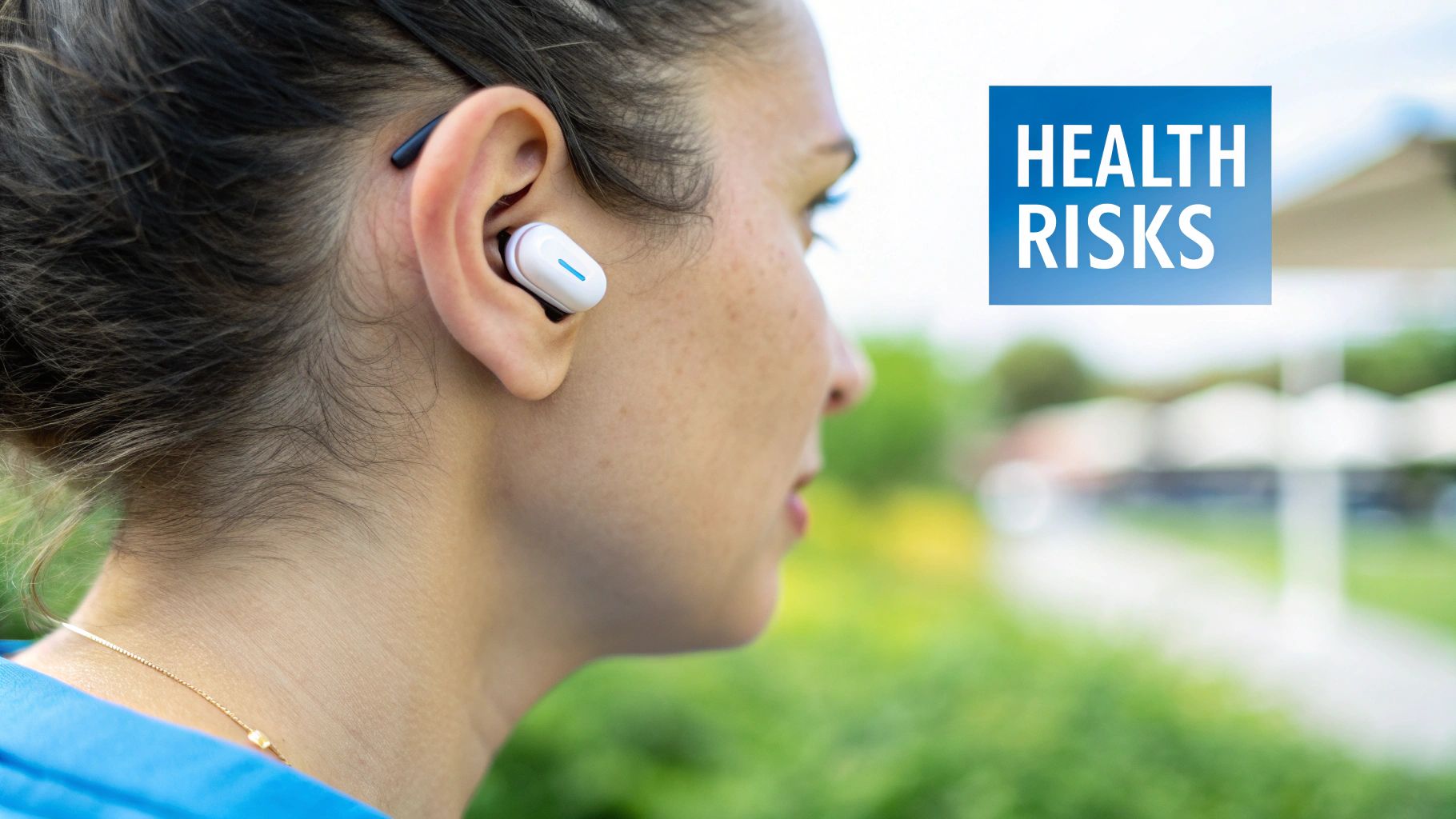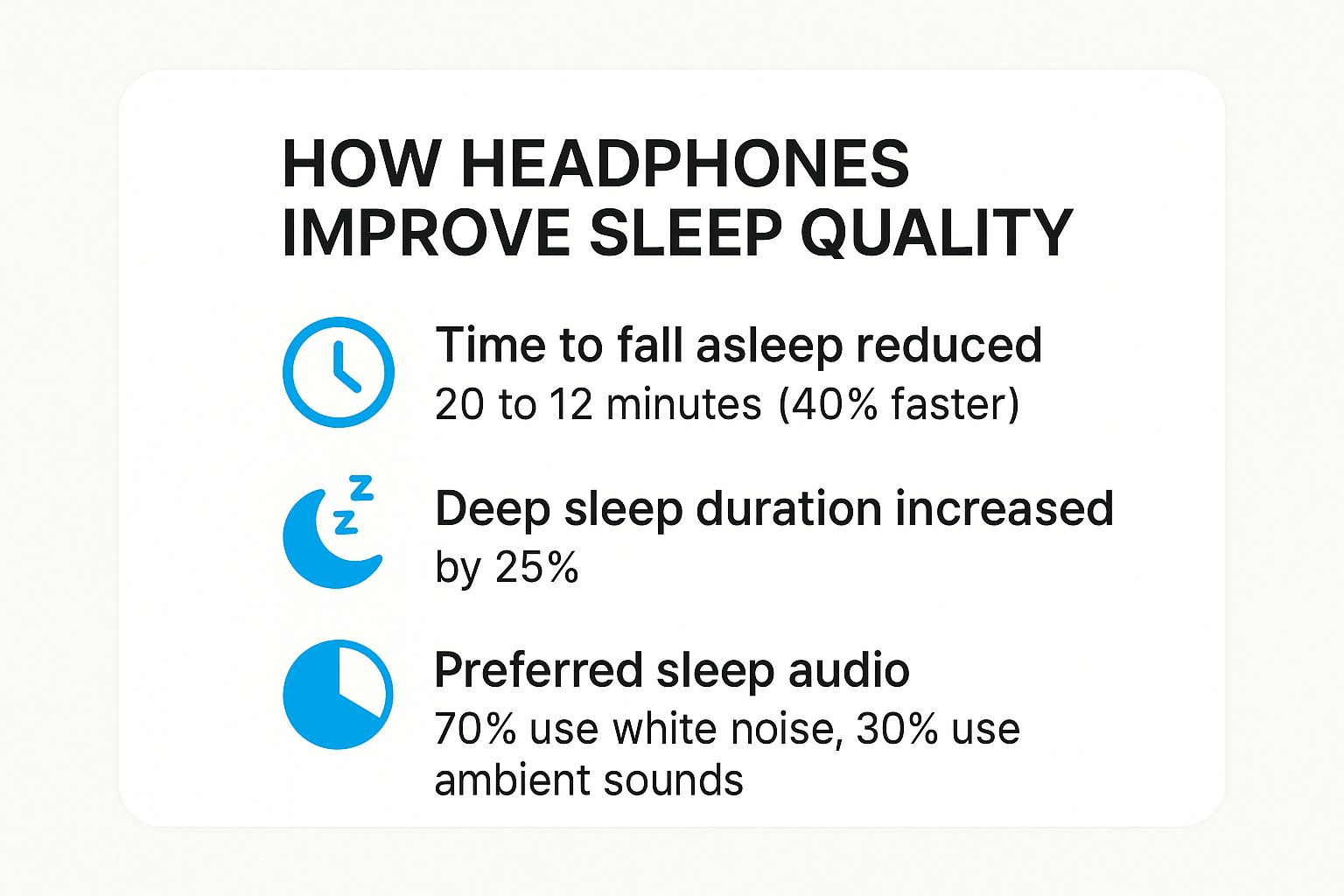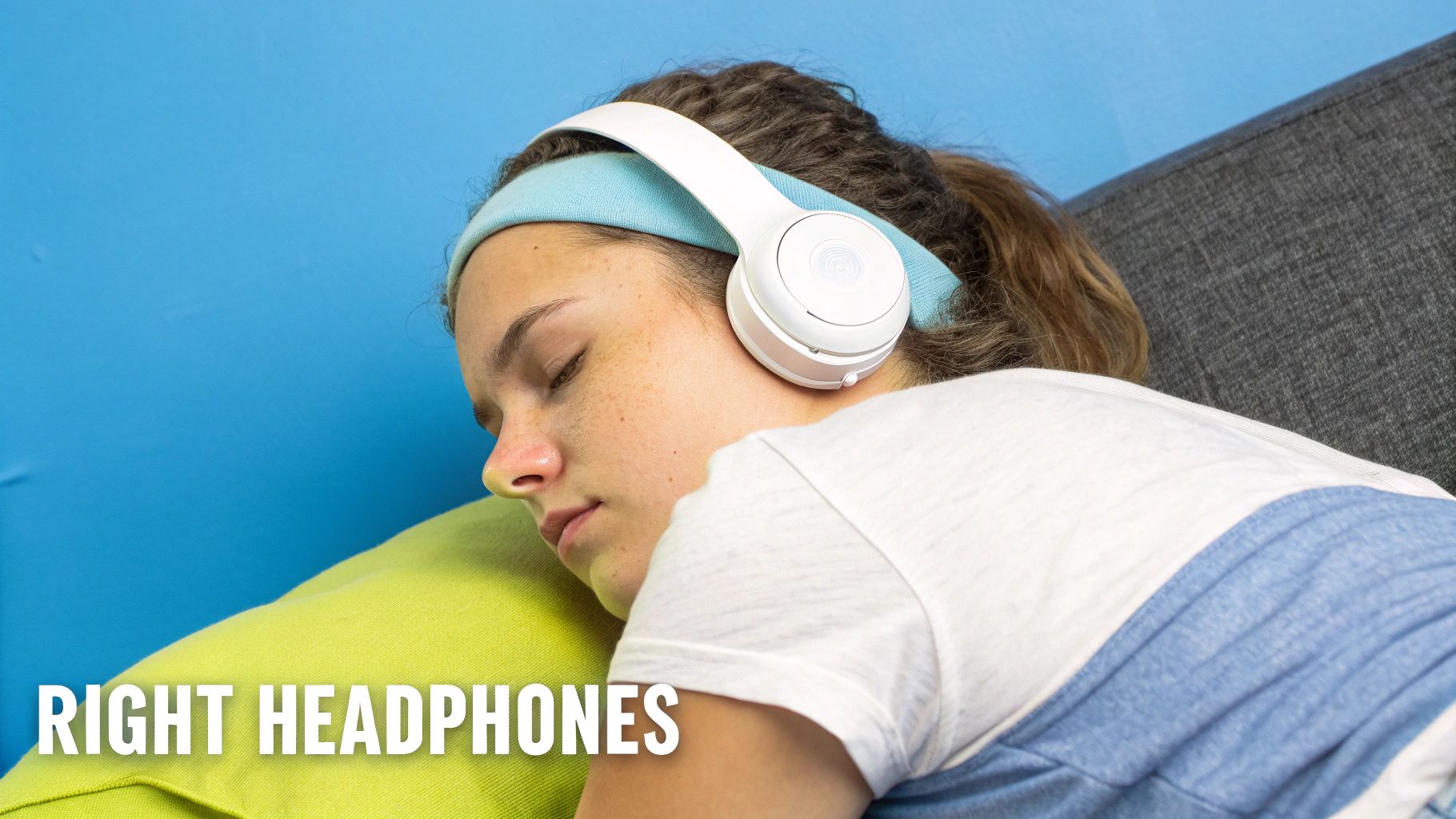So, you're wondering if it's okay to sleep with headphones. The short answer is yes, you can, but the real story is a little more complicated. It's one thing to drift off to your favorite podcast, but it's another thing entirely to do it safely, night after night.
Think of it as a popular way to build your own personal quiet bubble—a little sanctuary from the noise of the outside world. But like any tool, it has to be used the right way to avoid causing more problems than it solves.
The Honest Answer to Sleeping With Headphones

Let’s face it, many of us practically need some kind of audio to wind down. Whether you’re trying to drown out a snoring partner, the bass thumping from your neighbor’s apartment, or just the general buzz of city life, headphones can feel like a lifesaver. They help create a consistent, peaceful soundscape that can help you fall asleep faster and, hopefully, stay asleep longer.
But there's always a trade-off, isn't there? Using the wrong kind of headphones—or even the right ones improperly—can open a can of worms. We're talking about everything from minor discomfort to more serious issues like hearing damage, painful ear infections, and even some surprising safety risks.
The real trick is finding that sweet spot between the amazing sleep benefits and the potential downsides.
Weighing the Pros and Cons
Before you make headphones a regular part of your bedtime routine, it helps to look at the whole picture. On one hand, they give you incredible control over your sound environment, which is a huge factor in getting restorative sleep. Listening to calming sounds or white noise can become a powerful signal to your brain that it's time to shut down for the night, creating a solid bedtime ritual.
On the other hand, the risks are very real. Those big, bulky over-ear cans can create painful pressure spots, especially if you're a side sleeper. In-ear buds can trap moisture and lead to wax buildup or nasty ear infections. And maybe the most critical risk of all? Not being able to hear a smoke alarm, a security alert, or a child calling for you in the middle of the night.
The goal isn't just to fall asleep with headphones on. It's to do it in a way that actually supports your overall health and well-being, rather than chipping away at it.
That’s what this guide is all about—helping you figure out how to get the good without the bad. We’ll dive into the specific health concerns, talk about the proven sleep benefits, and give you some practical, no-nonsense tips for picking the right gear and using it safely. Once you have all the facts, you can decide if this is the right move for you.
A Quick Look at Sleeping With Headphones
To make things even clearer, let's break down the main points. Here’s a quick summary of the potential benefits and risks you should consider before making it a nightly habit.
| Aspect | Potential Benefits | Potential Risks |
|---|---|---|
| Noise Control | Effectively blocks out disruptive sounds like snoring, traffic, or noisy neighbors. | May prevent you from hearing important alerts like smoke alarms, break-ins, or a child in distress. |
| Sleep Quality | Calming audio (music, podcasts, white noise) can reduce the time it takes to fall asleep. | Can lead to hearing damage over time if the volume is too high for extended periods. |
| Comfort & Physical | Creates a personal "sound bubble" that can reduce anxiety and promote relaxation. | Bulky headphones can cause discomfort, pressure sores, or ear canal irritation, especially for side sleepers. |
| Ear Health | Can be part of a relaxing bedtime routine, signaling to your brain that it's time to sleep. | In-ear buds can increase wax buildup and trap moisture, potentially leading to ear infections. |
| Habit Formation | Provides a consistent auditory cue for sleep, which can be helpful for conditioning sleep. | Could lead to a dependency where you find it difficult to sleep without them. |
Ultimately, the decision comes down to your personal needs, your sleeping environment, and your willingness to prioritize safety.
Understanding the Health Risks Involved

While drifting off to your favorite podcast sounds like a dream, it's smart to know about the potential health issues that can pop up if headphones become a nightly habit. These aren't just about minor annoyances; we're talking about real concerns for your hearing, physical safety, and even basic hygiene.
Knowing the "why" behind these risks is the first step toward finding a safer way to sleep with sound.
The biggest long-term danger is Noise-Induced Hearing Loss (NIHL). You might think keeping the volume low is all it takes, but the duration of the sound is just as critical as its intensity. Think of your ears like a muscle that needs to rest. Blasting them with constant sound for eight hours straight, night after night, can cause slow but permanent damage to the tiny hair cells inside your ear.
This isn't just a hypothetical problem. One study on headphone users found that a staggering 74.1% showed signs of subclinical hearing loss—damage that’s already there but isn't causing obvious symptoms yet. It’s a quiet reminder that what you do tonight can seriously impact your hearing down the road. You can learn more from the research on headphone use and hearing loss.
Physical Discomfort and Ear Health
Beyond hearing loss, there are more immediate physical problems to think about, especially depending on the type of headphones you're using.
- Pressure Sores: Big, bulky over-ear headphones can create painful pressure points, particularly if you're a side sleeper. That constant pressure can cut off blood flow and lead to sores and cartilage pain over time. Nobody wants that.
- Ear Canal Issues: In-ear buds that create a tight seal are also a problem. They block air from circulating, creating a warm, moist environment—basically a perfect party for bacteria. This can really up your risk of getting a painful outer ear infection.
- Wax Buildup: Earbuds can also shove earwax deeper into your ear canal instead of letting it work its way out naturally. Over time, this can lead to impacted wax, causing that annoying full feeling in your ear, muffled hearing, or even tinnitus (a constant ringing).
Critical Safety and Awareness Concerns
Maybe the most immediate danger of sleeping with headphones is being completely cut off from the world around you. That same sound-blocking feature that helps you sleep can become a serious liability in an emergency.
By design, effective noise-masking headphones prevent you from hearing the very things that are designed to save your life. This includes smoke alarms, carbon monoxide detectors, security system alerts, or even a baby crying out from another room.
And let's not forget about older, wired headphones. They introduce a physical strangulation risk. While it’s rare, tossing and turning in your sleep could cause the cord to wrap around your neck. For this reason alone, if you're going to sleep with headphones, a wireless model is a much, much safer bet. These are all critical factors to weigh when deciding if you can sleep with headphones safely.
How Headphones Can Improve Your Sleep Quality
Despite the risks we've covered, there's a good reason so many of us are trying to figure out how to sleep with headphones. When you do it right, the benefits can be a game-changer. The right audio can transform your bedroom from a space full of distractions into a personal sanctuary for deep, restorative sleep.
The biggest win comes from something called sound masking.
Picture this: a sudden, sharp noise like a car horn or a slamming door is like a bright camera flash in a pitch-black room. It’s jarring. It grabs your attention immediately and yanks you right out of sleep.
Now, imagine you turn on a soft, dim lamp in that same room. That sudden flash from outside is way less noticeable because the overall light level is higher. Sound masking works the exact same way with noise.
By creating a consistent, gentle "cocoon of sound" with something like white noise or ambient audio, you raise the baseline level of sound in your room. This makes those sudden, disruptive noises far less likely to startle you awake, allowing your brain to stay in deeper sleep stages for longer.
This infographic really drives home the improvements people see when they get sound masking right.

The numbers don't lie. A controlled audio environment doesn't just help you drift off faster; it seriously boosts the quality of your sleep once you're there.
Creating a Powerful Bedtime Ritual
Beyond just blocking out the world, headphones can become the anchor for a powerful bedtime ritual. Listening to the same calming music, guided meditation, or gentle nature sounds every single night creates a strong psychological cue. It’s like telling your brain, "Okay, the day is officially over. Time to shut down."
This kind of consistency helps regulate your internal clock, making it much easier to feel sleepy at the same time each night. And the benefits are real and measurable, especially for those of us who struggle to get to sleep in the first place.
For example, a 2022 study looked at healthcare shift workers—a group that knows a thing or two about difficult sleep schedules. They found that using noise-masking earbuds during sleep led to a huge jump in self-reported sleep quality. Participants also felt less tired during the day and even noticed a reduction in daily tension. Better nights really do lead to better days.
You can read the full research about these sleep quality findings if you want to dive into the details. The takeaway is clear: a consistent audio environment helps you fall asleep faster and get more of the deep, restorative sleep your body needs to repair and recharge.
Choosing The Right Headphones For Sleeping

So, you've weighed the pros and cons and decided that blocking out the world is worth it for a good night's rest. The next step is absolutely crucial: picking the right gear. Not all headphones are created equal, and your standard gym earbuds or bulky over-ears are almost guaranteed to cause more problems than they solve.
Think of it like choosing running shoes. You wouldn't run a marathon in hiking boots, would you? The same logic applies to the eight-hour marathon of sleep. You need specialized equipment designed for the job.
Why Your Everyday Headphones Just Won't Cut It
Let's get real about why your go-to headphones are a terrible choice for bed. Each type comes with its own set of issues that will wreck your sleep instead of improving it.
- Over-Ear and On-Ear Headphones: These are the big, bulky ones. While they're fantastic for immersive sound during the day, they create a ridiculous amount of pressure when you lie on your side. This quickly leads to sore ears and can even damage your cartilage over time.
- Traditional In-Ear Earbuds: You might think something like an AirPod is small enough, but they stick out from your ear canal. When a side sleeper rolls over, that hard plastic gets jammed deeper into the ear. It's not just painful; it increases the risk of wax buildup and nasty ear infections.
These headphones were never designed for the unique pressures of sleeping. They prioritize sound quality for someone who is upright and active, not lying down and trying to relax. For a deeper dive, check out our guide to finding seriously comfortable headphones for bed.
The Rise Of Specialized Sleep Headphones
Thankfully, manufacturers have caught on to this problem and developed headphones specifically for sleeping. These designs put a low-profile fit, soft materials, and long-term comfort way ahead of pure audio fidelity.
The two most popular styles you'll find are sleep headbands and ultra-thin on-ear headphones, like our Bedphones.
Sleep headbands are pretty clever—they embed flat speaker discs inside a soft, stretchy fabric band. This design takes all the pressure off your ears and makes sure the speakers stay put, even if you toss and turn.
On the other hand, you have ultra-thin headphones. These rest gently on the ear with soft foam padding and are often less than a quarter-inch thick. This incredibly slim profile makes them almost unnoticeable, even when your head is pressed right into the pillow.
Comparing Your Options
Not sure which style is right for you? It really boils down to personal preference and how you sleep. Let’s lay out the options so you can see what features matter most for your comfort and safety.
Comparing Different Headphone Types For Sleep
Here’s a quick breakdown of how common headphone types stack up for overnight use. Pay close attention to the disadvantages—they're often the deal-breakers.
| Headphone Type | Best for Side Sleepers? | Key Advantages | Key Disadvantages |
|---|---|---|---|
| Over-Ear | No | Excellent sound quality and noise isolation. | Extremely bulky, heavy, and causes severe pressure. |
| In-Ear Earbuds | No | Portable and discreet for daytime use. | Uncomfortable pressure, risk of ear infection, falls out easily. |
| Sleep Headbands | Yes | Very comfortable, keeps ears uncovered. | Can feel warm for some users, audio quality is secondary. |
| Bedphones | Yes | Ultra-thin and lightweight, minimal pressure. | On-ear design may not block as much external noise as in-ear models. |
Ultimately, investing in a pair of headphones specifically designed for sleep is the single most important step you can take. It minimizes the risks and ensures you're actually getting the benefits you were hoping for in the first place.
Practical Safety Tips for Nightly Headphone Use
Knowing the risks is one thing, but actually doing something about them is what really counts. If you’ve decided that listening to something as you drift off is worth it, a few simple habits can make all the difference. Think of them as your nightly non-negotiables for protecting your hearing, keeping your ears healthy, and making sure you can still hear the smoke alarm.
It’s like creating a pre-sleep checklist. You lock the doors, you turn off the lights, and you set up your audio safely. These quick steps become a natural part of your routine, letting you get the peaceful rest you’re after without any of the worry.
Protect Your Hearing and Awareness
First things first: let's cover the two most critical habits. These aren’t just suggestions—they’re essential if you want to do this long-term without causing damage.
Keep the volume low. This one is absolutely non-negotiable. Unsafe listening is a huge problem, and some studies show that as many as 17% of teenagers are already showing early signs of hearing loss from headphone use. A lot of headphones can easily blast sound over 100 decibels (dB), which can cause permanent damage in just 15 minutes. Your volume only needs to be high enough to gently mask outside distractions, not to drown them out completely.
Next, use a sleep timer. Your ears need a break. Letting audio play all night long means you're subjecting them to constant stimulation, which builds up the risk of hearing fatigue and permanent issues down the line. Most podcast and music apps have a sleep timer built right in—find it and use it. Set it for 30 or 60 minutes, which is usually plenty of time to fall asleep.
By setting a timer, you're giving your ears hours of pure silence to rest and recover. This dramatically cuts down on your cumulative noise exposure night after night.
Choose Smart Content and Maintain Hygiene
What you listen to and how you care for your gear are just as important as volume and timers.
- Opt for Calming Audio: Stick to content that’s monotonous and soothing. Things like white noise, ambient sounds (think gentle rain), or soft instrumental music are perfect. Steer clear of anything that will keep your brain engaged, like fascinating podcasts, audiobooks with a gripping plot, or upbeat music. That stuff will just mess with your sleep cycles.
- Practice Good Hygiene: This is a big one, especially if you use in-ear headphones. Give them a regular cleaning. A quick wipe-down with an alcohol-free cleaner prevents nasty buildup of earwax and bacteria that can lead to infections. It's also a smart move to give your ears a total break one or two nights a week.
These steps are simple, but they make a massive impact. For a complete look at all the best practices, check out our detailed guide on how to sleep with headphones the safe and comfortable way.
Exploring Alternatives for a Quiet Night
So you’ve weighed the pros and cons and decided that sleeping with headphones just isn’t for you. That’s perfectly okay. The good news is, you don’t actually need to wear anything on your head to get that peaceful, quiet bedroom you’re craving.
Several excellent alternatives can create that same cocoon of sound, minus the physical contact.
A dedicated white noise machine is a fantastic place to start. Unlike an app on your phone, these devices are built for one job: producing high-quality, non-looping sound that smothers disruptions. They create a consistent audio blanket that covers up jarring noises like traffic or a snoring partner, which can be a game-changer for your sleep quality. You can dive deeper into the science behind this in our guide on how does white noise help you sleep.
Low-Tech and Smart Solutions
Beyond specialized gadgets, plenty of other options work just as well—and you might already own one.
- Smart Speakers: Devices like Google Home or Amazon Alexa are champs at playing hours of ambient sounds. Just ask for anything from gentle rain to a steady fan hum, and you're good to go.
- Low-Tech Soundproofing: Never underestimate the power of simple physical barriers. A good set of heavy, dense blackout curtains can absorb a surprising amount of street noise and light.
The goal is to create a sleep environment that feels safe and tranquil. Whether you use a high-tech gadget or a simple pair of curtains, controlling your soundscape is a powerful step toward better rest.
Ultimately, finding the right solution comes down to your personal comfort and what truly helps you disconnect from the day’s noise and drift off.
Still Have Questions? Let's Clear a Few Things Up
Even after covering the basics, you probably have some specific questions running through your mind. It's totally normal. This is where we tackle some of the most common worries people have when asking, "is it really okay to sleep with headphones?"
Let's get into it.
What About Sleeping With AirPods or Wireless Earbuds?
Sure, they're convenient for daytime use, but sleeping with standard wireless earbuds like AirPods can be a bad idea. Their hard plastic shells just aren't made for the pressure of side-sleeping, and they can dig painfully into your ear canal.
They also form a tight seal, which can trap moisture. Over time, this can lead to wax buildup or even painful outer ear infections. And because they stick out, they have a knack for falling out in the middle of the night, only to be lost in your sheets until morning. For a safe and comfortable night, you're always better off with headphones designed specifically for sleep—they're softer, much thinner, and built to be forgotten.
When it comes to nightly use, the best headphones are the ones you barely notice. Standard earbuds are simply too bulky and hard for eight hours of comfortable, safe rest, especially if you sleep on your side.
Can Sleeping With Headphones Cause Tinnitus?
Yes, unfortunately, there's a very real link here. Tinnitus, that frustrating ringing or buzzing sound that won't go away, can absolutely be caused by long-term noise exposure—even at volumes that don't seem that loud.
Think about it: when your ears are getting a constant stream of sound for hours, night after night, it can wear down the tiny, delicate hair cells inside your inner ear. This damage is often permanent and is a primary cause of tinnitus. The best way to sidestep this serious risk is to always keep the volume as low as you possibly can and set a sleep timer so the audio isn't playing all night. Your ears need a break, too.
What’s the Safest Kind of Audio for Sleep?
The safest audio is something consistent, calming, and free of any jarring changes. You want audio that fades into the background, not something that grabs your attention.
- White, pink, or brown noise: These are fantastic choices. Their steady, humming frequencies are brilliant at masking distracting outside noises without being mentally engaging.
- Gentle ambient sounds: Picture things like a steady, soft rainfall, the whir of a fan, or the rhythm of ocean waves.
- Minimalist instrumental music: Look for tracks without complex melodies, vocals, or dramatic shifts in tempo or volume.
What should you stay away from? Engaging podcasts, complex music with lots of changes, or suspenseful audiobooks. These things keep your brain fired up and active right when it's supposed to be winding down, which can seriously mess with your natural sleep cycles.
Ready to find a solution that’s actually designed for comfortable, all-night listening? DubsLabs created super-thin Bedphones to solve these exact problems. See the difference for yourself and explore our sleep-enhancing products at https://www.dubslabs.com.











































